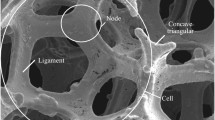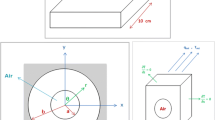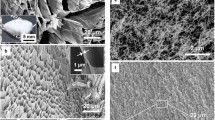Abstract
Incorporation of porosity into a monolithic material decreases the effective thermal conductivity. Porous ceramics were prepared by different methods to achieve pore volume fractions from 4 to 95%. A toolbox of analytical relations is proposed to describe the effective thermal conductivity as a function of solid phase thermal conductivity, pore thermal conductivity, and pore volume fraction (νp). For νp < 0.65, the Maxwell–Eucken relation for closed porosity and Landauer relation for open porosity give good agreement to experimental data on tin oxide, alumina, and zirconia ceramics. For νp > 0.65, the thermal conductivity of kaolin-based foams and calcium aluminate foams was well described by the Hashin Shtrikman upper bound and Russell’s relation. Finally, numerical simulation on artificially generated microstructures yields accurate predictions of thermal conductivity when fine detail of the spatial distribution of the phases needs to be accounted for, as demonstrated with a bio-aggregate material.














Similar content being viewed by others
References
W. Schulle and E. Schlegel: Fundamentals and properties of refractory thermal insulating materials (High-temperature insulating materials), in Ceramic Monographs–Handbook of Ceramics, Supplement to Interceram. 40(7), No. 2.6.3, 1–12 (1991).
D.S. Smith, S. Fayette, S. Grandjean, C. Martin, R. Telle, and T. Tonessen: Thermal resistance of grain boundaries in alumina ceramics and refractories. J. Am. Ceram. Soc. 86, 105–111 (2003).
H.S. Yang, G.R. Bai, L.J. Thompson, and J.A. Eastman: Interfacial thermal resistance in nanocrystalline yttria stabilized zirconia. Acta Mater. 50, 2309–2317 (2002).
A. Michot, D.S. Smith, S. Degot, and C. Gault: Thermal conductivity and specific heat of kaolinite: Evolution with thermal treatment. J. Eur. Ceram. Soc. 29, 347–353 (2008).
F.R. Charvat and W.D. Kingery: Thermal conductivity: XIII, effect of microstructure on conductivity of single-phase ceramics. J. Am. Ceram. Soc. 40, 306–315 (1957).
J. Bourret, E. Prudhomme, S. Rossignol, and D.S. Smith: Thermal conductivity of geomaterial foams based on silica fume. J. Mater. Sci. 47, 391–396 (2012).
H.S. Carslaw and J.C. Jaeger: Conduction of Heat in Solids (Oxford University Press, London, 1959).
M.J. Assael, M. Dix, K. Gialou, L. Vozar, and W.A. Wakeham: Application of the transient hot-wire technique to the measurement of the thermal conductivity of solids. Int. J. Thermophys. 23(3), 615–633 (2002).
S. Gustafsson: Transient plane source techniques for thermal conductivity and thermal diffusivity measurements of solid materials. Rev. Sci. Instrum. 62(3), 797–804 (1991).
A. Degiovanni: Thermal diffusivity and flash method. Rev. Gen. Therm. 185, 420–441 (1977).
W.J. Parker, R.J. Jenkins, C.P. Butler, and G.L. Abbott: Flash method of determining thermal diffusivity, heat capacity, and thermal conductivity. J. Appl. Phys. 32(9), 1679–1684 (1961).
P.G. Klemens: Thermal conductivity and lattice vibrational modes. Solid State Phys. 7, 1–98 (1958).
R. Berman: The thermal conductivity of some polycrystalline solids at low temperatures. Proc. Phys. Soc. London, Sect. A 65, 1029–1040 (1952).
S. Raghavan, H. Wang, R.B. Dinwiddie, W.D. Porter, and M.J. Mayo: The effect of grain size, porosity and yttria content on the thermal conductivity of nanocrystalline zirconia. Scr. Mater. 39, 1119–1125 (1998).
C. Kittel: Interpretation of the thermal conductivity of glasses. Phys. Rev. 75, 972–974 (1949).
J. Fleig and J. Maier: A finite element study on the grain boundary impedance of different microstructures. J. Electrochem. Soc. 145, 2081–2089 (1998).
D.S. Smith, S. Grandjean, J. Absi, S. Founyapte Tonyo, and S. Fayette: Grain boundary thermal resistance in polycrystalline oxides: Alumina, tin oxide and magnesia. High Temp. High Press. 35–36, 93–99 (2004).
D.A. Young and H.J. Maris: Lattice-dynamical calculation of the Kapitza resistance between fcc lattices. Phys. Rev. B: Condens. Matter 40, 3685–3693 (1989).
P.G. Collishaw and J.R.G. Evans: An assessment of expressions for the apparent thermal conductivity of cellular materials. J. Mater. Sci. 29, 2261–2273 (1994).
A.L. Loeb: Thermal conductivity: VIII, a theory of thermal conductivity of porous materials. J. Am. Ceram. Soc. 37, 96–99 (1954).
J. Maxwell: A Treatise on Electricity and Magnetism (Clarendon Press, Oxford, 1892).
Z. Hashin and S. Shtrikman: A variational approach to the theory of the effective magnetic permeability of multiphase materials. J. Appl. Phys. 33, 3125–3131 (1962).
L. Rayleigh: On the influence of obstacles arranged in rectangular order upon the properties of medium. Philos. Mag. 5(34), 481–502 (1892).
R. Landauer: The electrical resistance of binary metallic mixtures. J. Appl. Phys. 23, 779–784 (1952).
G. Ticha, W. Pabst, and D.S. Smith: Predictive model for the thermal conductivity of porous materials with matrix-inclusion type microstructure. J. Mater. Sci. 40, 5045–5047 (2005).
H. Russell: Principles of heat flow in porous insulators. J. Am. Ceram. Soc. 18, 1–5 (1935).
M.F. Ashby: The properties of foams and lattices. Philos. Trans. R. Soc. London, Ser. A 364, 15–30 (2006).
E. Litovsky, M. Shapiro, and A. Shavit: Gas pressure and temperature dependances of thermal conductivity of porous ceramic materials: Part 2, refractories and ceramics with porosity exceeding 30%. J. Am. Ceram. Soc. 79(5), 1366–1376 (1996).
G. Reichenauer, U. Heinemann, and H.P. Ebert: Relationship between pore size and the gas pressure dependence of the gaseous thermal conductivity. Colloids Surf., A 300, 204–210 (2007).
J.S.Q. Zeng, P.C. Stevens, and A.J. Hunt: Thin-film-heater thermal conductivity apparatus and measurement of thermal conductivity of silica aerogel. Int. J. Heat Mass Transfer 39(11), 2311–2317 (1996).
D. Baillis and R. Coquard: Radiative and conductive thermal properties of foams, in Cellular and Porous Materials: Thermal Properties Simulation and Prediction, edited by A. Ochsner, G.E. Murch, and M.J.S. de Lemos (Wiley-VCH, Weinheim, 2008).
S. Grandjean: Réponse thermique à l’échelle locale dans les matériaux céramiques, effets des pores et des joints de grains. Ph.D. Thesis, University of Limoges, 2002.
P. Turkes, C. Pluntke, and R. Helbig: Thermal conductivity of SnO2 single crystals. J. Phys. C: Solid State Phys. 13, 4941–4951 (1980).
Z. Zivcova, E. Gregorova, W. Pabst, D.S. Smith, A. Michot, and C. Poulier: Thermal conductivity of porous alumina ceramics prepared using starch as a pore-forming agent. J. Eur. Ceram. Soc. 29, 347–353 (2009).
B. Nait-Ali, K. Haberko, H. Vesteghem, J. Absi, and D.S. Smith: Thermal conductivity of highly porous zirconia. J. Eur. Ceram. Soc. 26, 3567–3574 (2006).
J. Bourret, N. Tessier-Doyen, B. Nait-Ali, F. Pennec, A. Alzina, C.S. Peyratout, and D.S. Smith: Effect of pore volume fraction on the thermal conductivity and mechanical properties of kaolin based foams. J. Eur. Ceram. Soc. 33(9), 1487–1495 (2013).
F. Pennec, A. Alzina, N. Tessier-Doyen, B. Nait-Ali, and D.S. Smith: Probabilistic thermal conductivity analysis of dense stabilized zirconia ceramics. Comput. Mater. Sci. 67, 207–215 (2013).
F. Krauss Juillerat, U.T. Gonzenbach, A.R. Studart, L.J. Gauckler: Self-setting particle-stabilized foams with hierarchical pore structures. Mater. Lett. 64, 1468–1470 (2010).
U.T. Gonzenbach, A.R. Studart, E. Tervoort, and L.J. Gauckler: Ultrastable particle-stabilized foams. Angew. Chem. Int. Ed. 45, 3526–3530 (2006).
U.T. Gonzenbach, A.R. Studart, E. Tervoort, and L.J. Gauckler: Stabilization of foams with inorganic colloidal particles. Langmuir 22, 10983–10988 (2006).
F. Pennec, A. Alzina, N. Tessier-Doyen, B. Nait-Ali, N. Mati-Baouche, H. De Baynast, and D.S. Smith: A combined finite-discrete element method for calculating the effective thermal conductivity of bio-aggregates based materials. Int. J. Heat Mass Transfer 60, 274–283 (2013).
Author information
Authors and Affiliations
Corresponding author
Rights and permissions
About this article
Cite this article
Smith, D.S., Alzina, A., Bourret, J. et al. Thermal conductivity of porous materials. Journal of Materials Research 28, 2260–2272 (2013). https://doi.org/10.1557/jmr.2013.179
Received:
Accepted:
Published:
Issue Date:
DOI: https://doi.org/10.1557/jmr.2013.179




